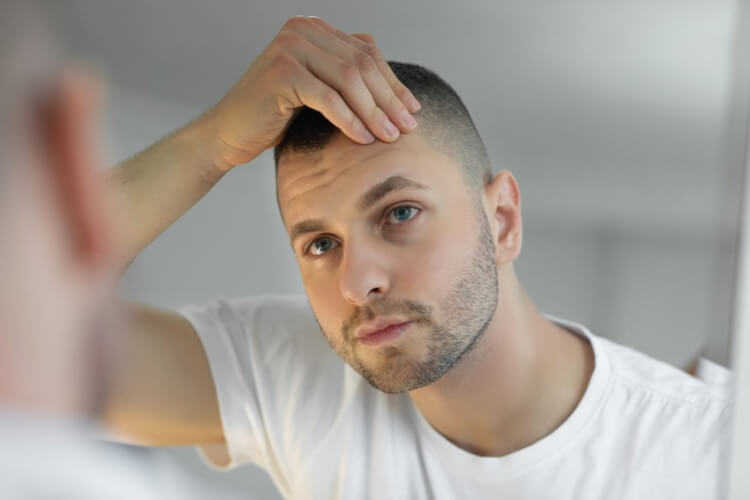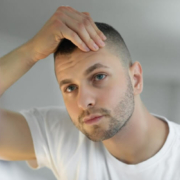Can Boosting Your Testosterone Levels Prevent Hair Loss?

My Dad never had much hair, even when he was in his twenties. If you’re familiar with The Love Boat, he looked just like Captain Stubing. There was such a resemblance that people would often stop my parents for an autograph and a photo when they went on cruises. My brother, sister, and I always had a good laugh when they got home and told us about their encounters. Besides that, I never thought much about my Dad’s hair, or I should say, lack of hair. Why would I?
When I recently mentioned my hair loss, my Dad shared with me that he visited a dermatologist when his hair first started falling out. Back then, little research had been conducted, no medications were available, and his dermatologist couldn’t help. The doctor politely told my Dad that balding is a natural part of aging and that he would have to learn to live with it. So, that’s what he did.
Fortunately, times have changed. Ongoing research is guiding treatment plans, and prescription medications such as Finasteride, Spironolactone, and Dutasteride are now available to promote hair growth among people with male and female pattern baldness. One of the breakthrough findings is a link between testosterone and hair loss. How are they connected? Is a low testosterone level the cause of your hair loss? We’re here to fill you in.
What is Testosterone?
Testosterone is the primary sex hormone in men. The hormone supports the development of the penis and testes. It also affects men’s voices, facial hair, muscles, bones, libido, and sperm production. Women also produce testosterone in their ovaries and adrenal glands. In women, testosterone affects ovarian function and bone strength. (01) The amount of testosterone produced is important. Contrary to popular belief, low testosterone levels are not the culprit when it comes to male and female pattern hair loss, also known as androgenic alopecia. High levels of testosterone are at the root of the problem. (02) However, not all testosterone is created equal.
What Are The Types Of Testosterone?
Two forms of testosterone exist in the body. Only one type contributes to hair loss. The first type is free testosterone which does not bind to any proteins in your body. This type of testosterone is absorbed by cells to help your body function. Free testosterone does not affect your hair.
Dihydrotestosterone (DHT) is another story. An enzyme called 5-alpha reductase converts testosterone to DHT hormones. When DHT is created, the hormone binds to your hair follicles, causing miniaturization. When the follicles miniaturize, they reduce in size, thinning your hair, and preventing new growth from emerging.
How Do You Know If Your Testosterone Level is Causing Androgenic Alopecia
There isn’t one specific test that will tell you definitively if your hair loss is due to high levels of DHT. (03) Dermatologists typically make a clinical diagnosis based on your pattern of hair loss. A typical hair loss pattern in men with male pattern baldness is an M shape that gradually extends to the crown. Women with female pattern baldness often see diffuse thinning on their crowns. The frontal area isn’t usually affected in women. In some cases, dermatologists will do blood work or take a small biopsy. The tests are typically ordered to rule out other causes of alopecia.
Can Your Testosterone Levels Affect Your Eyebrows, Eyelashes, and Other Facial Hair?
Just like the hair on your scalp, eyebrows, eyelashes, mustaches, and beards can be affected when your body produces too much DHT. Oral DHT blockers and topical medications explicitly designed for facial hair help fill in the gaps the same way they do for the hair on your head.
Can You Treat Male and Female Pattern Hair Loss by Adjusting Your Testosterone Level?
DHT Blockers are available to prevent DHT from attacking your hair follicles. The topical and oral medications are designed to prevent further hair loss and stimulate regrowth. Fortunately, androgenic alopecia progresses slowly. The earlier you begin treatment, the better the results you will get. The most effective DHT blockers are only available by prescription. Here is a rundown of what is available and often recommended:
Finasteride
Finasteride is often prescribed off-label to men and women not of childbearing age. The medication is a 5-alpha-reductase inhibitor which has been proven to be effective in numerous research studies. One study found that 48 percent of participants who used Finasteride showed improved hair growth at one year and 66 percent at 2 years compared to 7 percent of participants who received a placebo. (04)
Spironolactone
Spironolactone is prescribed off-label to women to treat female pattern hair loss. According to the Journal of the American Academy of Dermatology, all patients in a four-year study from 2015-2019 saw hair growth after using Spironolactone. Patients who used the medication for a longer time realized more growth. (05)
Dutasteride
Men often use Dutasteride in conjunction with Flomax to treat enlarged prostates. The medication is also used off-label to treat male pattern baldness and has been found to be highly effective. Dutasteride is often used as a second line of attack if Finasteride does not give the desired results. Patients can easily switch from Finasteride to Dutasteride without any issues or significant side effects.
Minoxidil
Although Minoxidil is often recommended to people experiencing male and female pattern hair loss, it is not a DHT blocker. The topical liquid and foam work by enlarging the hair follicles and preventing miniaturization. Minoxidil is often used with Finasteride, Spironolactone, Dutasteride, and other hair loss medications.
Do DHT Blockers Have Side Effects?
People who take oral medications tend to experience more side effects than people who use topical medications. While side effects from topical Finasteride are limited to mild irritation, two to three percent of patients who take oral Finasteride experience sexual side effects such as low libido. The reason why is because oral medications are systemic, while topicals only penetrate at the point of contact. With topical Finasteride, your overall testosterone level is not affected. With oral, it is.
Many patients ask if Dutasteride has more side effects than Finasteride since Dutasteride has a longer half-life. That means Dutasteride stays in your system longer, making it a more potent medication. Interestingly, the side effect profile is about the same for both medicines. Dutasteride does not cause more side effects.
Do Topical Finasteride and Other DHT Blockers Cause Shedding or Clog the Hair Follicles?
It’s rare that Finasteride or Dutasteride would cause your hair to shed when you first start using the medications. This initial shedding is called shock loss. On the other hand, Minoxidil can cause shock loss due to mild irritation that sometimes occurs when patients first start using the medicine. The shedding typically stops after the first six to eight weeks of using the medication.
If you’re concerned that topical medications could clog your hair follicles and prevent growth, you can take a deep breath. It’s a myth that anything topical will prevent your hair from growing. Even people who have dandruff are not at risk. Dandruff is an indication of inflammation as opposed to blocked hair follicles.
Will Testosterone Replacement Therapy (TRT) Help Prevent Hair Loss?
Men often use prescription testosterone injections or gels as Testosterone Replacement Therapy (TRT) to restore testosterone to normal levels. (06) Many wonder whether the TRT will help stop male pattern baldness from getting worse. Quite the contrary often happens. TRT increases testosterone levels, increasing the DHT that causes hair loss. If your doctor prescribes TRT, it’s important to work with him or her to find the right balance. Topical DHT blockers can also help counteract the effects of TRT.
Is Your Hair Thinning or Falling Out Due to an Excessive Response to DHT?
Male and female pattern baldness is passed through your family genetically. If you are predisposed, you will have an excessive response to androgens, causing you to lose your hair. The condition is progressive and can start any time after puberty begins.
If you are experiencing male or female pattern baldness, DHT blockers may be just what the doctor ordered. To find out if DHT blockers are suitable for you, contact us. We have board-certified dermatologists and hair specialists available to review your history and answer any questions.
Resources:
(01) https://www.health.harvard.edu/medications/testosterone–what-it-does-and-doesnt-do
(02) https://skinkraft.com/blogs/articles/testosterone-hair-loss
(03) https://bestpractice.bmj.com/topics/en-us/223
(04) https://pubmed.ncbi.nlm.nih.gov/9951956/
(05) https://www.jaad.org/article/S0190-9622(20)30510-7/fulltext
(06) https://www.health.harvard.edu/mens-health/is-testosterone-therapy-safe-take-a-breath-before-you-take-the-plunge



